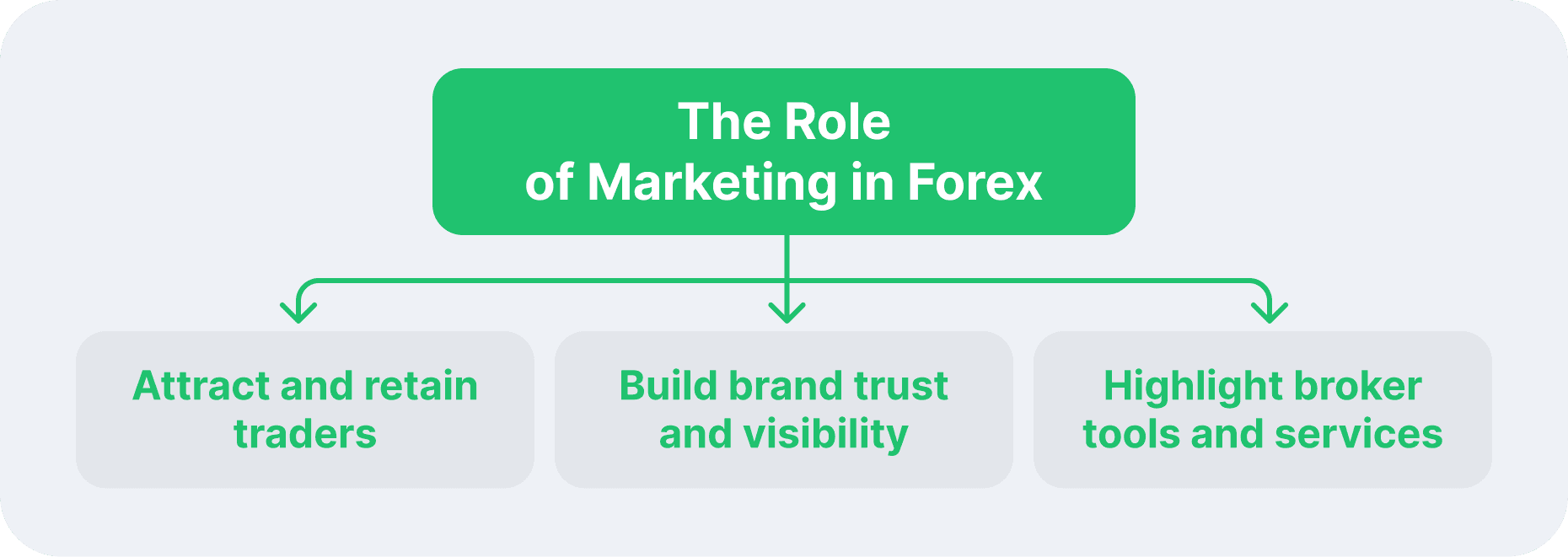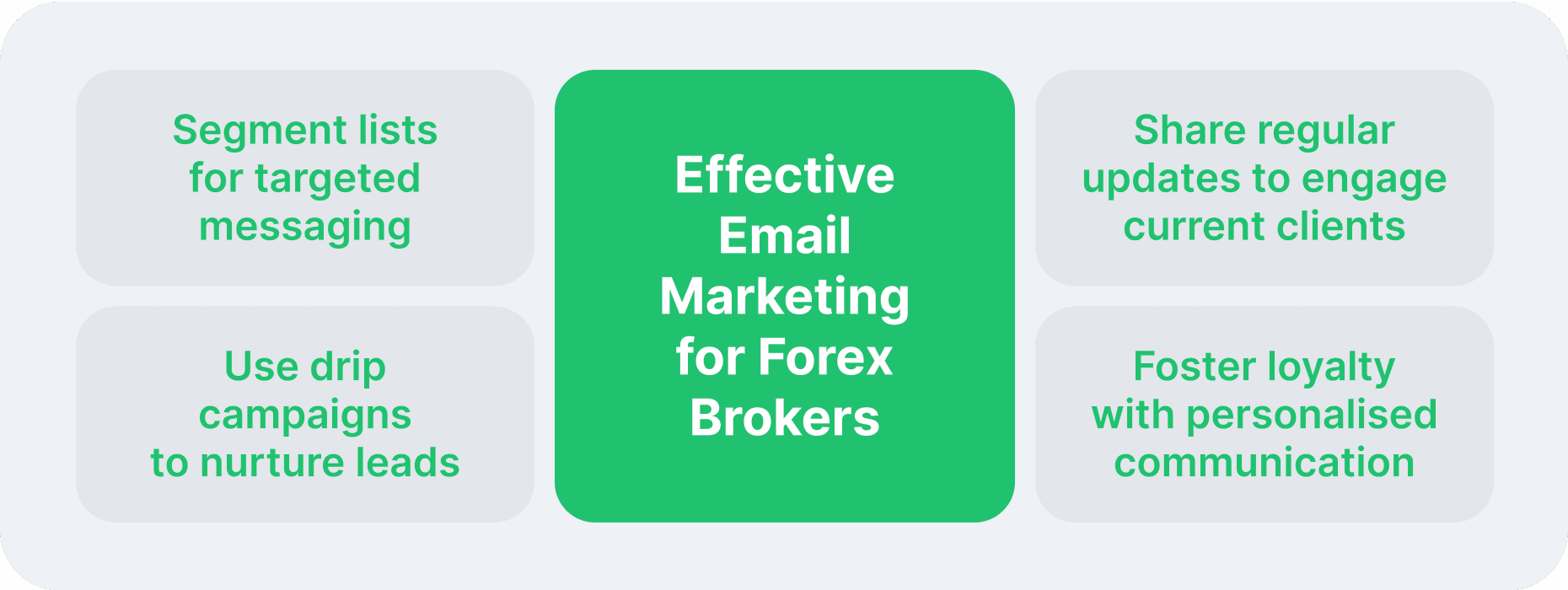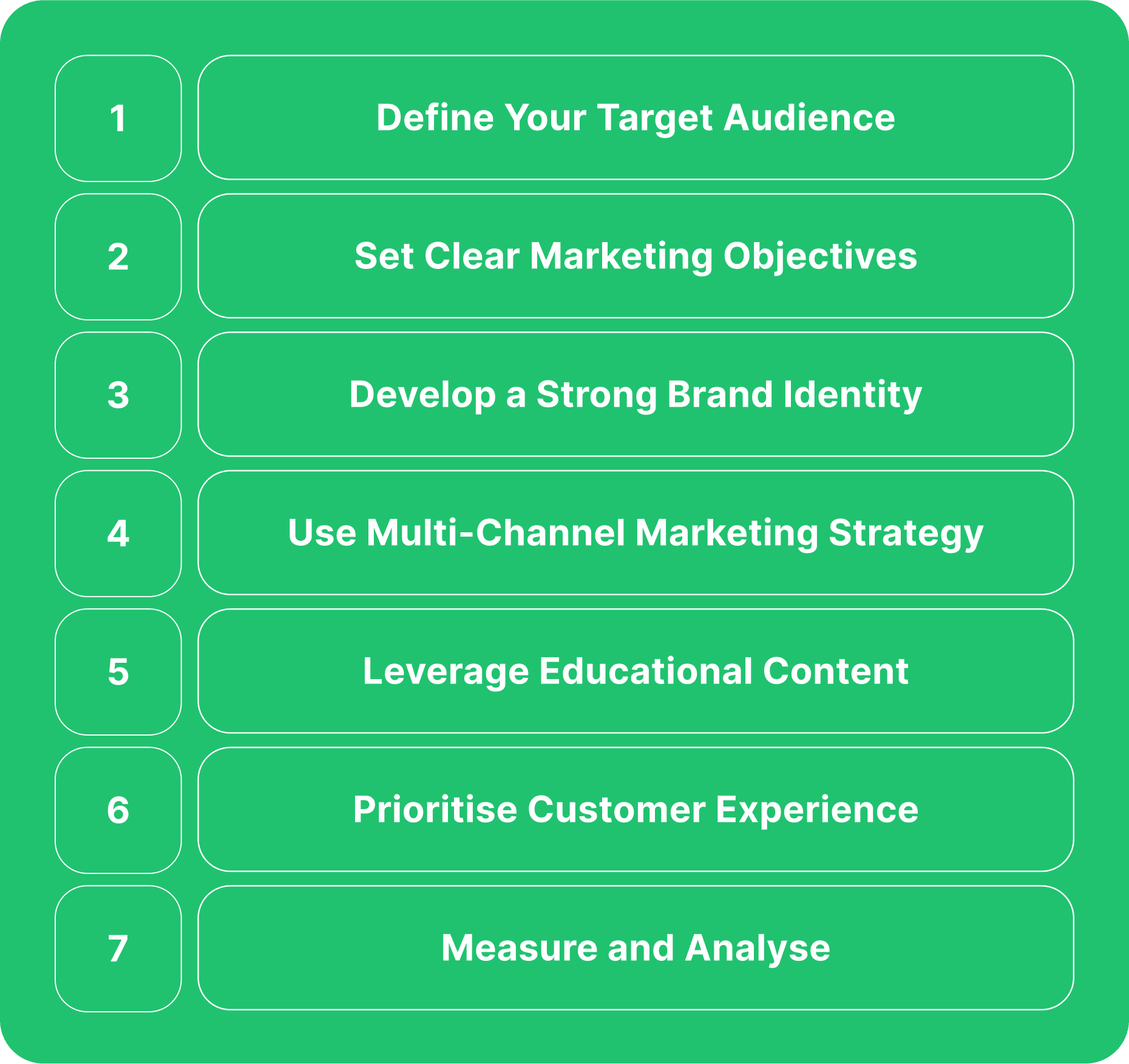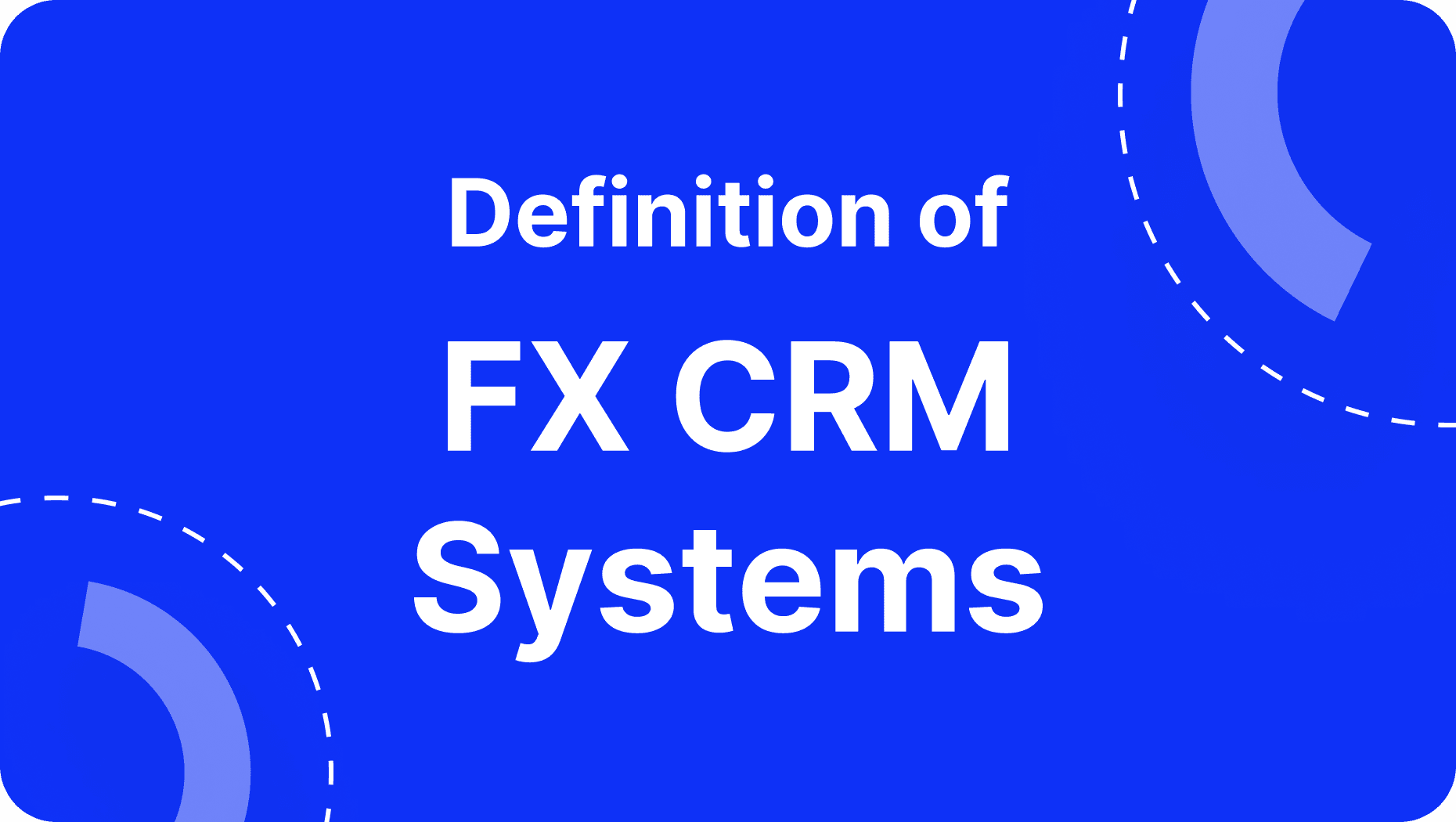Share
0
/5
(
0
)
The FX market is still one of the most competitive financial arenas. Due to rising volatility and worldwide financial factors, brokers and traders must constantly adapt to changing conditions.
To stay ahead, a flexible Forex broker marketing plan that considers recent developments and shifts in trader behaviour is necessary. Brokers must know how to create a successful Forex marketing strategy to attract customers.
The article will cover some of the most popular Forex marketing strategies for engaging with traders more successfully and enhancing your brand's visibility. By efficiently targeting traders and providing insightful information about what is currently adequate, these tactics will help you maintain your competitive edge.
Key Takeaways
In the FX industry, a good brand stands out and builds trust.
Broker professionalism and trustworthiness are increased when communication is consistent across channels.
Webinars and instructional materials captivate traders and position brokers as authorities in their field.
Interactive content, targeted emails, and SEO all aid brokers in bringing in and keeping customers.
The Role of Marketing in Forex

Attracting and keeping customers is one of marketing's primary functions in any firm. Let’s look at the numbers: The digital advertising and marketing market is expected to grow from its anticipated $667 billion in 2024 to $786.2 billion in 2026.
Marketing increases brand awareness and fosters trust in the Forex business. By projecting an image of dependability and openness, a strong marketing plan for Forex company guarantees that traders will feel secure in the broker they select.
Establishing trust and brand visibility is essential, particularly when targeting traders who rely on technical and fundamental analysis.
Effective marketing campaigns focus on presenting valuable insights, highlighting how a broker's tools and services help traders make informed decisions.
By building a robust Forex broker marketing plan, a brokerage can attract new clients and retain experienced traders seeking consistent and reliable services.
Effective marketing can be the difference between a firm that thrives and one that struggles to remain afloat, as market trends and Forex trading strategies are always changing.
Forex Broker Branding: Building Trust and Long-Term Relationships

An essential part of the foreign exchange market is branding. A brokerage with a distinctive, recognisable brand stands out in the fiercely competitive Forex market.
Because traders are more likely to select a broker they are familiar with and trust, brand recognition and reputation are essential to success. In this context, branding encompasses more than just a slogan or symbol.
Whether traders seek a dependable broker, sophisticated trading techniques, or state-of-the-art tools, it's all about creating an identity that speaks directly to their demands.
Creating a Consistent Brand Message
It's crucial to keep your messaging consistent across all marketing platforms. Consistency in advertising, social media, and websites helps to reaffirm the broker's dependability and professionalism. A unified brand message should highlight the brokerage's key advantages, such as its effective risk management capabilities, educational materials, and security measures. Traders better grasp the broker's worth when they see the same message across several platforms.
To maintain a consistent brand message, Forex brokers should consider the following:
1. Developing a Strong Brand Identity
Create a unique brand voice that appeals to the intended market. Is it funny, convincing, or informative?
Design a unified visual identity with a font, colour scheme, and logo.
Develop an engaging brand narrative emphasising the broker's beliefs, mission, and distinctive selling propositions.
2. Leveraging Social Media
To keep your audience interested, post on a daily basis.
Make educational, aesthetically pleasing, and sharing-friendly content.
React to communications and comments in a timely and professional manner.
3. Content Marketing
Create excellent content that benefits your audience, such as blog entries, articles, and videos.
To increase visibility, make sure your material is optimised for the search engine.
Make sure your layout, colours, and fonts are all consistent.
4. Email Marketing
Target particular audience segments with customised email campaigns.
Make sure your brand identity is consistent across all of your email templates.
To increase conversions, ensure every email has a clear call to action.
Trust-Building Tactics
Trust is essential to drawing in and keeping institutional and retail customers. Security and transparency must be prioritised in all aspects of a trustworthy Forex broker business.
Emphasising characteristics like segregated accounts, strong encryption, and regulatory compliance can increase trader confidence. Marketing materials can also highlight the broker's initiatives to offer instructional resources that help traders make wise selections.
To generate trust with clients, you should consider these tactics:
Transparent Communication
Strong Regulatory Compliance
Effective Security Measures
Educational Resources
24/7 Customer Support
Content-Driven Marketing

One effective strategy to engage successful Forex trader is to offer educational materials. By providing insightful analysis and practical tactics, blogs, whitepapers, and trading guides assist brokers in establishing their authority in the Forex market.
These publications can address things like technical analysis of currency pairs, risk management techniques, and the best Forex trading strategies. By educating traders, brokers can build a reputation as reliable information providers and raise the possibility of enduring customer relationships.
By offering educational resources, Forex brokers may build a devoted following of knowledgeable traders and bring in fresh clients. Here’s how exactly:
Make material that appeals to various skill levels, from newbie to expert. For example, beginners can gain from basic tutorials on important ideas like technical and fundamental analysis. At the same time, seasoned traders can value in-depth examinations of more complex trading techniques like swing and high-frequency trading.
Add interactive components like calculators, simulations, and quizzes to make learning interesting and valuable. A risk management calculator, for instance, can assist traders in figuring out the best position sizes based on their account balance and risk tolerance.
Organise live workshops and webinars to address audience enquiries and offer real-time insights. These gatherings may address everything from market analysis to trading psychology.
Establish social media groups and online forums to help traders feel more connected to one another. This enables traders to talk about ideas, exchange experiences, and gain knowledge from each other.
Optimising for Search Engines
SEO is crucial to increasing organic traffic. A crucial component of any marketing strategy is content optimisation using long-tail search terms and Forex-related keywords.
Throughout the article, keywords like "currency pairs," "Forex trading strategy," and "price movements" should be used. On-page SEO can increase visibility by correctly using headers and creating meta descriptions. By implementing SEO strategies, brokers can attract new customers looking for trading ideas, market trends, and price data.
Content Formats That Work
Different content forms target traders of different skill levels. Blogs are a good way to get quick information about trading possibilities and the state of the Forex market. On the other hand, brokers can illustrate complex trading ideas like reversal patterns and risk management strategies through video training.
With a deeper examination of subjects like technical and fundamental analysis, eBooks assist traders in making wise choices when placing trades. Thanks to these forms, brokers can provide instructional materials suited to inexperienced and seasoned traders.
Here are several ideas to effectively engage a diverse range of traders:
1. Interactive Content
Give traders access to interactive trading simulators to improve their abilities without taking risks.
Make challenges and quizzes to assess traders' comprehension of essential ideas.
Add elements of gamification to your content to make learning entertaining and exciting.
2. Personalised Content
Provide traders with customisable dashboards so they can monitor their performance, examine market patterns, and get specific guidance.
Send personalised email newsletters based on personal preferences, such as favourite asset classes, trading style, and risk tolerance.
3. Community Building with Social Media Content
Establish online discussion boards where traders may exchange ideas, ask questions, and share experiences.
Create social media communities to interact with traders and create a feeling of connection.
Organise workshops and webinars to answer audience enquiries and offer professional insights.
[aa quote-global]
Fast Fact
Since 90% of marketers use content in their campaigns, the content marketing business is expected to reach a valuation of $600 billion by 2024.
[/aa]
Lead Nurturing with Email Marketing Campaigns

Forex brokers can send targeted communications to particular groups by segmenting their email lists. For instance, high-net-worth individuals may gain exclusive insights on high-frequency trading tactics and risk management.
At the same time, novice traders may receive instructional materials on currency markets and basic Forex trading strategies. Using segmentation, each group is guaranteed to receive pertinent information appropriate for their trading experience and style.
Think about a Forex broker that serves a wide range of customers, from inexperienced traders to seasoned pros. The broker can deliver highly targeted communications by segmenting their email list according to variables like preferred asset classes, risk tolerance, and trading experience.
Novice Traders: Emails with instructional materials, such as beginner's guides to Forex trading, lessons on technical analysis, and risk management techniques, may be helpful for clients new to trading.
Intermediate Traders: More complex subjects, including swing trading tactics, trading psychology, and advanced charting techniques, may interest this group.
Expert Traders: These customers could value unique perspectives on economic data, market trends, and innovative algorithmic and high-frequency trading techniques.
Below, let’s discuss some of the benefits of segmentation:
Brokers can raise open and click-through rates by providing pertinent material.
A closer bond with customers is fostered by personalised communication.
Specific actions, like registering for a webinar, creating a new account, or boosting trading volume, might be prompted by targeted communications.
Brokers can lower attrition and increase customer loyalty by catering to the unique requirements of each client segment.
Drip Campaigns
Automated email sequences called drip campaigns are intended to educate prospective traders gradually. The use of volume indicators, understanding price fluctuations, and current market trends are just a few of the fundamental Forex ideas these campaigns can teach leads.
As the series goes on, the emails may encourage readers to create accounts by emphasising the advantages of working with a trustworthy broker. Every message builds on the one before it, providing insightful details while keeping readers interested.
Nurturing Existing Clients
By providing frequent updates, Forex brokers may cultivate their current clientele. These updates may include price break analysis, new trading opportunities, and market sentiment surveys. Additionally, clients gain from fast updates on central bank operations, short-term market changes, and day trading methods.
Because of this constant communication, traders may stay informed and modify their tactics in response to market situations. Providing clients with innovative tactics and unique chances guarantees continued engagement and loyalty to the brokerage.
Webinars for Trader Retention

By holding frequent webinars and live training sessions, Forex brokers can keep traders on board. These occasions allow brokers to tackle certain trading difficulties, such as identifying trend reversal patterns or managing risk in volatile markets.
Important ideas like comprehending moving averages, executing trades based on price changes, and adjusting to shifting market conditions can also be covered in webinars. Brokers add value by giving traders practical advice on the best tactics and recent price changes, which motivates traders to keep trading.
The impact of webinars must be measured to evaluate their efficacy. Brokers can monitor participation rates to determine how many Forex traders attend live sessions and interact with the content. Brokers should keep an eye on participants' trading performance following webinars and attendance.
An increased trade volume, improved trading plan execution, or better informed long and short-term decisions could be outcomes of a successful webinar. Observing these variables may determine how successfully the webinars assist traders in lowering risk and adjusting to emerging currency market patterns.
Let’s take a look at some of the most effective webinar options:
Encourage audience interaction by using live chat, polls, and Q&A sessions. This keeps guests interested and promotes a feeling of community.
Ask professionals in the field to offer their expertise. This can increase the webinar's legitimacy and draw in more participants.
Send attendees individualised follow-up emails following each webinar. This could involve one-on-one consultations, session records, or other tools.
Use gamification components, such as challenges and quizzes, to add fun and interest to the learning process.
Crafting a Comprehensive Forex Broker Marketing Plan

The dynamic, multifaceted approach of a good Forex broker marketing plan should align with the target audience's changing needs. Brokers can develop a strong marketing plan that promotes expansion and client loyalty by integrating the components we mentioned above.
Here's a step-by-step approach to developing a comprehensive Forex broker marketing plan:
1. Define Your Target Audience
Determine distinct market categories according to trading style, risk tolerance, and experience level. Then, examine the objectives, problems, and preferred routes of communication of your target audience. To customise your marketing messaging, create thorough profiles of your prospective customers.
2. Set Clear Marketing Objectives
Clearly state your goals for your marketing campaigns, such as raising trading volume, gaining new customers, or enhancing brand recognition. Set up key performance indicators (KPIs) like website traffic, lead generation, and customer acquisition cost to monitor the effectiveness of your efforts.
3. Develop a Strong Brand Identity
Create a recognisable brand voice that captures the essence of your business. Don't forget to Keep your font, colour scheme, and logo memorable. Write a story that appeals to your target market and emphasises your special selling features.
4. Implement a Multi-Channel Marketing Strategy
Create excellent material to inform and interest your audience, such as blog entries, articles, and videos. It's essential to use social media sites like Instagram, LinkedIn, and Twitter to engage with your audience and establish a powerful online presence. Utilise email marketing to update your audience, promote exclusive deals, and nurture leads.
Use paid advertising platforms like social media and Google Ads to reach a larger audience. To increase organic visibility, make sure your content and website are search engine optimised. Ultimately, create favourable PR and cultivate connections with media outlets and industry influencers.
5. Leverage Educational Content
Organise workshops and webinars to gain your audience's trust and share professional thoughts. Write comprehensive manuals on various Forex subjects, including risk management, technical and fundamental analysis. And you can also provide thorough instruction in FX trading through online courses.
6. Prioritise Customer Experience
Offer customer service that is helpful and quick to respond. Provide trading platforms that are easy to use, intuitive and adapt your offerings to each client's unique requirements.
7. Measure and Analyse
Monitor important indicators such as customer satisfaction, conversion rates, and website traffic. To find patterns and areas for development, use analytics tools. Make data-driven choices to maximise your advertising expenditures.
We answered the question of what is Forex marketing. Following these steps and creating a marketing plan for Forex company can be one big step towards success.
Conclusion
Forex brokers must modify their marketing plans in 2024–2025 to remain competitive. Using SEO, focused email marketing, webinars, and valuable instructional content are essential strategies. Brokers can take advantage of possibilities in currency trading and apply high-frequency trading strategies by responding to the global economic recovery and the current market trend. These initiatives result from stronger market presence, better client retention, and steady growth.
FAQs
What is the best strategy for drawing in new FX traders?
A mix of tactics, such as email marketing, social media, and content marketing, can work well to draw in new Forex traders. You can position your business as a reliable expert by offering informative articles, webinars, and trading advice.
How can I increase the Forex industry's customer retention rate?
Concentrate on developing enduring relationships with your clients to increase customer retention. Provide individualised services, first-rate customer assistance, and useful educational materials. Also, loyalty programs and special incentives should be considered to encourage repeat business.
Which Forex marketing trends are the newest?
Influencer collaborations, social media marketing, and AI utilisation are a few of the most recent developments in FX marketing.
Read also





